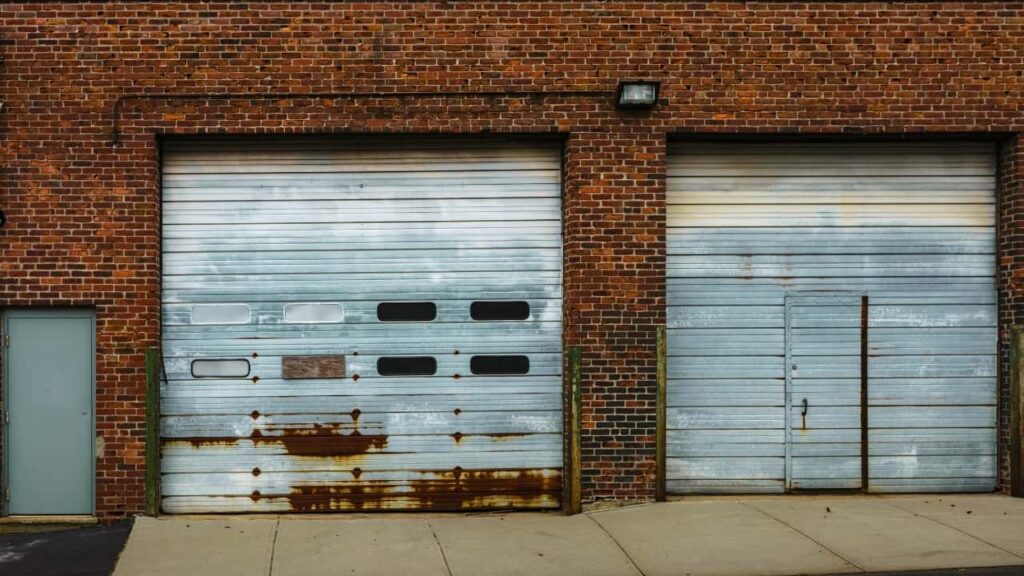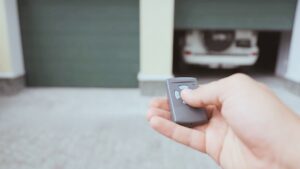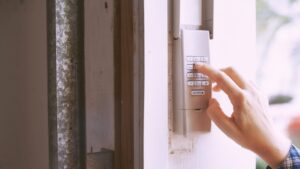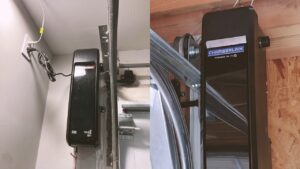Every year, an individual homeowner spends around $223 on garage door repairs. A significant portion of which is attributed to rust-related damages.
For homeowners, understanding and tackling garage door rust isn’t just about maintaining aesthetics; it’s about sidestepping hefty repair bills and safety hazards.
If you find yourself nodding, thinking, “That’s my garage door struggle!” hang tight.
This guide will become your rust-busting playbook, unveiling 7 easy DIY steps to reclaim your door’s former glory.
Let’s get started!
What Causes a Garage Door to Rust?
Rust is a common garage door problem among homeowners. But before we can resolve the issues, it’s important to understand what causes rust in the first place.
You might remember from Chemistry 101 that the reaction of iron with moisture and oxygen causes rust.
When these three elements collide (e.g., on the steel components of your garage door), they give birth to iron oxide (or rust) — a brittle, reddish-brown crust.
Rust is a form of metal corrosion that weakens the door’s structural integrity, impacts its operation, and leads to expensive repairs or replacements. Therefore, neglecting rust can be costly.
The problem of rust is more prevalent near the coast. Coastal homes are more likely to get garage door rust issues than those inland because saltwater accelerates rusting.
Regardless of where you live, rust is a common problem that most homeowners struggle to resolve. However, removing and preventing long-term structural deterioration is easier if you catch rust early on.
Connect With A Garage Expert
Connect with local experts, Compare quotes, Get the best price.
Signs of a Garage Door Rust
To catch rust in its earlier stages, it’s important to inspect each nook and cranny of your garage door carefully. During the inspection, be mindful of the following signs of rust:
Discoloration and Patches
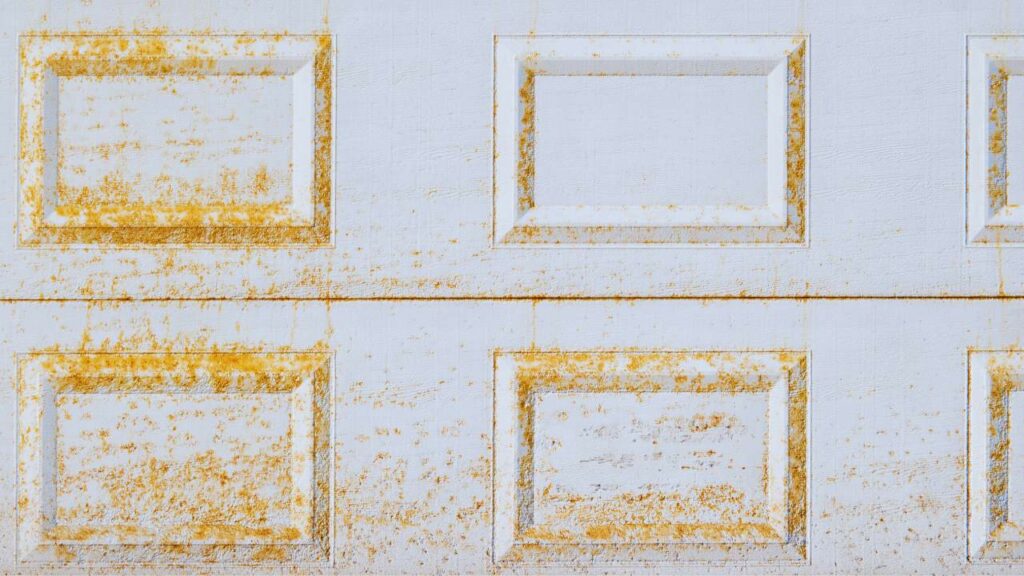
One of the most evident signs of rust is the appearance of brown or reddish patches, particularly on the lower sections. Homeowners often neglect this, thinking that it’s only dirt — it’s not. It’s often the earliest stage of rust formation.
Rough Texture
Run your hand gently over the door. If it feels gritty or rough in some spots, especially areas that look discolored, that’s likely rust beginning to take hold.
Difficulty in Operation
Signs of rust are not always visual. A garage door that makes a clicking noise, squeaks more than usual or doesn’t glide smoothly will likely have rusted parts affecting its motion. This could be in the hinges, tracks, or even the springs.
Overall, a garage door is an intricate assembly of parts, and rust can play foul anywhere. Being vigilant and recognizing these signs early on is key to ensuring your garage door’s long, hassle-free life.
How Do I Get Rid of Rust on My Garage Door?
Removing rust from your garage door is essential for its longevity and visual appeal. But before undertaking this task, you must be equipped with the right tools and materials.
Tools Needed
Every successful project starts with the right toolkit. A specific lineup of essential tools for a rust-free garage door guarantees the job gets done right.
- Sturdy gloves for protection
- Top-grade sandpaper for effective rust removal
- rust remover solution
- Rust-inhibiting primer
- Durable paint matching your garage door’s color
- Soft-bristle brush for cleaning
- Steel wool for a tougher rust spot
- Paintbrush or roller for application
- Safety goggles to protect eyes
- Drop cloth or plastic sheeting
Now that we’ve got all the right tools for removing rust let’s walk through the process step by step.
Step 1: Identify if It Is Rust
Authentic rust spots on a garage door feel rough to the touch and carry a distinct brown-red hue. If you’re unsure, a simple touch or close inspection often sets rust apart from mere dirt.
Step 2: Take Precautionary Measures
Once you’ve confirmed it’s rust, get ready to remove it by equipping yourself with the tools and safety gear you’ll need.
Arm yourself with protective gloves and safety goggles to shield yourself against possible scrapes and prevent rust particles or debris from causing harm.
Step 3: Clean the Door
With safety gear on, it’s time to clean the door. A mild soap and water mix works wonders to eliminate grime, dirt, and initial rusty water stains. A thorough wash ensures no hindrance when addressing the primary rust spots.
Step 4: Sand the Rusty Areas
Employ medium-grit sandpaper to scrub off the rust from the affected patches gently. This not only eradicates the rust but also smoothens the door’s surface, prepping it for the subsequent steps.
Step 5: Clean Away Residual Dust
The sanding process might leave behind dust and particles. Use a clean cloth to remove these residuals to reveal a surface ready for treatment.
Step 6: Apply Rust-Inhibiting Primer
Applying a layer of rust-inhibiting primer guards against potential rust recurrence. Moreover, it paves the way for a smoother paint application.
To apply the rust-inhibiting primer, follow the steps below:
- Use a brush to apply a thin coat.
- Make sure that you apply the coat evenly.
- Always allow the primer adequate drying time as per its instructions.
- Apply additional layers for added protection.
Step 7: Repaint the Treated Sections
Finally, repaint the treated sections. Paint over the areas you’ve treated with a color matching your garage door. Always opt for paint designed for exterior use and, specifically, metal surfaces for optimal results and lasting protection.
Connect With A Garage Expert
Connect with local experts, Compare quotes, Get the best price.
How to Prevent Rust on Garage Door?
Preventing rust is way easier than dealing with its aftermath. For homeowners keen on preserving their garage doors, here are some pivotal prevention tips to consider:
1. Look For Quality Materials
Invest in a garage door made from rust-resistant materials, like aluminum or fiberglass, for a solid defense against rust. While the initial investment might be a bit much, it pays off in the long run.
2. Clean Regularly

Dirt, grime, and salt can hasten to rust. Therefore, thoroughly wash your garage door every month to keep the rust away. To wash your garage door, thoroughly apply a mixture of mild soap and water, then thoroughly rinse.
3. Apply Protective Sealant
Apply a protective sealant, especially at the bottom edge of the garage door. This forms a barrier against moisture — and prevents rust.
To apply a protective sealant, follow the steps below:
- Clean the surface and then dry it.
- Once the surface is clean and dry, apply the protective sealant.
- Depending on the product’s recommendations, you can use a paintbrush, roller, or spray.
- Apply multiple layers for better results.
Note: Pay special attention to the bottom edge of the door, as this is where moisture is most likely to seep in and cause rust.
4. Schedule Annual Inspections
Remember to consider the power of a thorough annual inspection by an expert. These inspections help catch early signs or potential vulnerabilities and save you hefty repair bills down the road.
5. Ensure Proper Drainage
Since water is the main reason behind garage door rust, you should prevent standing water at all costs. For this, you must ensure your driveway and garage’s foundation have good drainage systems that prevent water from lingering at your door’s base.
You’ll notice puddles near your driveway if you’ve got poor drainage. Another common sign is cracked and broken asphalt.
To prevent water from puddling near your garage door:
- Adjust the ground slope so that water flows away from the garage.
- Add a French drain to your driveway or landscaping. You can dig a narrow trench to add a U-shaped channel (made from steel or PVC). This will make the water flow away from your garage door.
- Inspect your gutters. Clear any debris to allow proper flow of water. Seal any cracks or leaks; replace them as soon as possible if they’re a lost cause.
Note: Most of these steps require professional expertise. Therefore, it’s best to hire a professional to fix your drainage system
6. Lubricate Moving Parts

Rust doesn’t just affect the door’s surface. It can affect important moving parts, thus impairing garage door functionality. But you can easily prevent this by using silicone-based lubricants.
Follow the steps below to lubricate the moving parts:
- Vacuum away the dust from the garage door tracks.
- Wipe off the remaining dirt with a damp rag.
- Now lift up the door (it’s best if you have someone to help).
- Apply the lubricant on the hinges as the door bends.
- Now, lubricate the small ball bearings of your garage door rollers.
- Use a step ladder to reach the garage door springs.
- Apply the lubricant on the garage door springs and the bearing plates (on each side of the garage door).
- Now open and close your garage door so the lubricant is spread evenly.
- Lubricate the top rail and arm bar.
- Last but not least, lubricate the garage door lock.
Lubricate the moving parts of your garage door every six months to ensure that your garage door functions smoothly and rust-free.
7. Paint and Prime
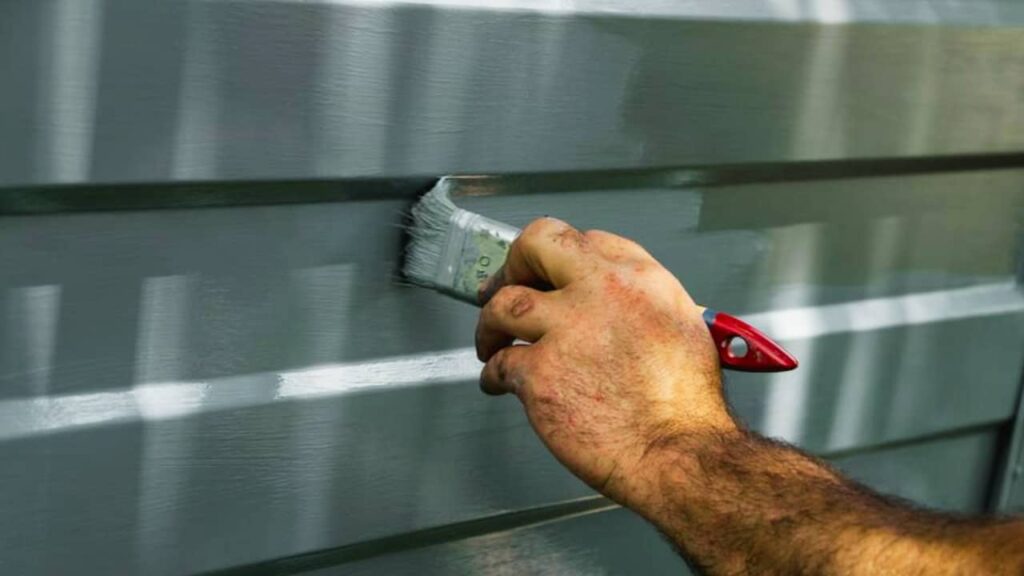
A fresh coat adds beauty and shields against rust. So, make it a habit to touch up chipped areas with rust-inhibiting paint and primer immediately.
Follow the steps below to do that:
- Clean the damaged spot by brushing off scrapes, dirt, and debris.
- Apply a coat of rust-resistant primer.
- Let it dry completely. Wait at least three hours.
- Once dry, apply a couple of coats of your favorite paint. Let the paint dry in between coats.
Conclusion
Taking proactive care of your garage door isn’t just a fleeting chore—it’s a long-term investment. Regular maintenance prevents garage door rust and reduces repair costs down the road.
To sum up, garage door rust removal entails identifying the rust, cleaning, sanding, and applying protective coatings to affected areas. However, prevention is always better. So always ensure regular cleaning, using quality materials, and annual inspections.
Remember, the few hours you dedicate today to your garage door can save you from unnecessary hassles tomorrow.
However, if you’re still unsure, hire a professional garage door service to advise you on the best possible solution.

